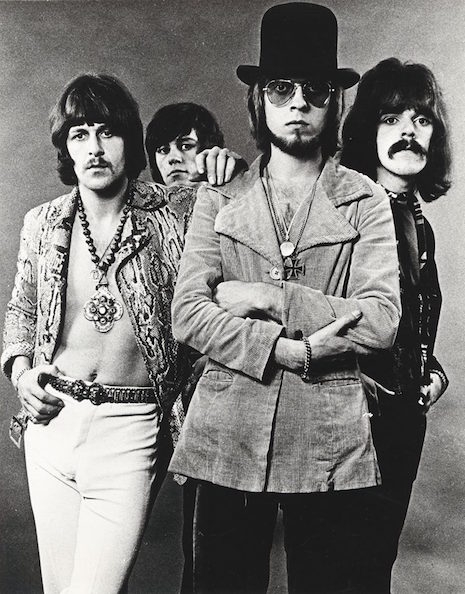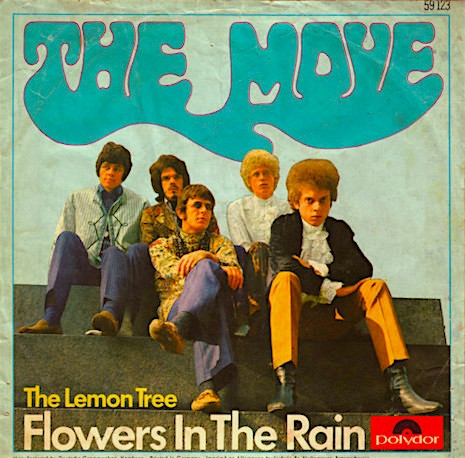
It’s one of those odd quirks of fate why sixties beat group The Move never became as big as say The Who, Kinks or the Dave Clark Five or even (crikey!) The Beatles or The Stones. There are many reasons as to why this never happened—top of the tree is the fact The Move never broke the American market which limited their success primarily to a large island off the coast of Europe. Secondly, The Move was all too often considered a singles band—and here we find another knotty problem.
The Move, under the sublime writing talents of Roy Wood, produced singles of such quality, range and diversity it was not always possible to identify their unique imprint. They evolved from “pioneers of the psychedelic sound” with their debut single “Night of Fear” in 1966—a song that sampled Tchaikovsky’s 1812 Overture—through “I Can Hear The Grass Grow” and “Flowers In The Rain” to faster rock songs like “Fire Brigade”—which inspired the bassline for the Sex Pistols’ “God Save the Queen”—to the chirpy pop of “Curly” and “Omnibus” to sixties miserabilism “Blackberry Way” and early heavy metal/prog with “Wild Tiger Woman,” “Brontosaurus” and “When Alice Comes Back to the Farm.” Though there is undoubtedly a seriousness and considered process going on here—it was not necessarily one that brought together a united fan base. Those who bought “Flowers in the Rain” were not necessarily going to dig the Hendrix-influenced “Wild Tiger Woman” or groove along to “Alice Comes Back to the Farm.”
That said, The Move scored nine top ten hits during the sixties, were critically praised, had a considerable following of screaming fans, and produced albums which although they were considered “difficult” at the time (Shazam, Looking On and Message from the Country) are now considered pioneering, groundbreaking and (yes!) even “classic.”
The Move was made up from oddments of musicians and singers from disparate bands and club acts who would not necessarily gravitate together. Formed in December 1965, the original lineup consisted of guitarist Roy Wood (recently departed from Mike Sheridan and The Nightriders), vocalist Carl Wayne who along with bass player Chris ‘Ace’ Kefford and drummer Bev Bevan came from The Vikings, and guitarist Trevor Burton from The Mayfair Set. Each of these artists had a small taste of success—most notably Carl Wayne who had won the prestigious Golden Orpheus Song Festival in Bulgaria—but nothing that was going to satisfy their ambitions for a long and rewarding career.
It was David Bowie—then just plain David Jones—who suggested Kefford and Burton should form their own band. They recruited Wood onto the team sheet and decided to follow another piece of Bowie’s advice to bring together the very best musicians and singers in their hometown of Birmingham. This they did. And although technically it was Kefford’s band, Carl Wayne by dint of age steered the group through their first gigs.

The Move’s greatest asset was Roy Wood—a teenage wunderkind who was writing songs about fairies and comic book characters that were mistakenly believed to have been inspired by LSD. This gave the band their counterculture edge when “Night of Fear” was released in 1966. They were thought to be acidheads tuning into the world of psychedelia a year before the Summer of Love—but as drummer Bev Bevan later recalled:
Nobody believed that Roy wasn’t out of his head on drugs but he wasn’t. It was all fairy stories rooted in childhood.
Young Wood and Wayne may have been squeaky clean but the rest of the band certainly enjoyed the sherbets—with one catastrophic result.
After chart success of “Night of Fear,” The Move were expected to churn out hit after hit after hit. Though Wood delivered the goods—the financial rewards did not arrive. Ace Kefford later claimed the pressure of touring, being mobbed by fans, having clothes ripped—and once being stabbed in the eye by a fan determined to snip a lock of his hair—for the same money he made gigging with The Vikings made it all seem rather pointless.
But their success continued apace. By 1967, The Move had three top ten hits, were the first band played on the BBC’s new flagship youth channel Radio One, and were touring across the UK and Europe. They also caused considerable controversy with their live stage act which involved Carl Wayne chopping up TV sets with an axe. While the golden youth were wearing flowers in their hair and singing about peace and love, The Move were offering agitprop political theater.
Then they were sued by British Prime Minister Harold Wilson.
The Move’s first manager Tony Secunda decided to promote the single “Flowers in the Rain” with a satirical postcard of PM Harold Wilson in bed with his secretary, Marcia Williams. The postcard was Secunda’s wholly idea, and had nothing to do with the band. Unfortunately, Wilson did not find the satirical caricature funny and sued for libel. He won the case. All of Wood’s royalties for the single were paid over to Wilson, who donated them to charity—a situation that continues to this day.
By now the drugs were having a drastic effect on Ace Kefford who fried his brain with LSD. As he later told Mark Paytress for the liner notes for The Very Best of the Move his mind melted at a fancy dress party at Birmingham’s Cedar Club:
There were all these little men sitting around me with pointed heads and big noses and long fingers that touched the floor. They were with me all night, man. Acid screwed my life up, man. It devastated me completely.
The Move toured with Jimi Hendrix (who was a fan) and had Pink Floyd as support. They also supplied backing vocals to Hendrix’s track “You Got Me Floatin’.” Working with Hendrix sent Wood off to find a heavier sound for the band. which led to “Wild Tiger Woman” and a gradual move towards early Heavy Metal.
When Carl Wayne quit the band—to tour the cabaret circuit—Roy Wood took over vocals and brought in Jeff Lynne from The Idle Race. Trevor Burton then quit—he (oddly) wanted The Move to be more Country and Western—so Wood brought in Rick Price from the Sight and Sound.
Lynne proved the ideal partner for Wood. However, it was all too late and The Move were headed for the inevitable split that led to the phoenix-like creation of the Electric Light Orchestra (which originally consisted of Wood, Lynne and Bevan) before Wood quit to form Wizzard.
How good were The Move? No point asking me, I’m biased. But if you do ask, they were very, very good. In fact, they were an excellent band who competed with The Beatles and The Stones for innovation and pop originality. However, they never won the same success, not even close. To get an idea of how good they were, take a look at their performance on Colour Me Pop from January 1969 when The Move were a four piece band consisting of Wood, Wayne, Bevan and Burton. They are tight, loud, and unlike so many over-produced bands today, sounded the same live as they did on record.
Set List: “I Can Hear The Grass Grow,” “Beautiful Daughter,” “The Christian Life,” “Flowers in the Rain,” “The Last Thing On My Mind,” “Wild Tiger Woman,” “Goin’ Back,” “Fire Brigade,” “Something” and “Blackberry Way.”
Deluxe remastered editions of The Move’s albums Move, Something Else from The Move, Shazam, Looking On and Message from the Country are released this month—details here.